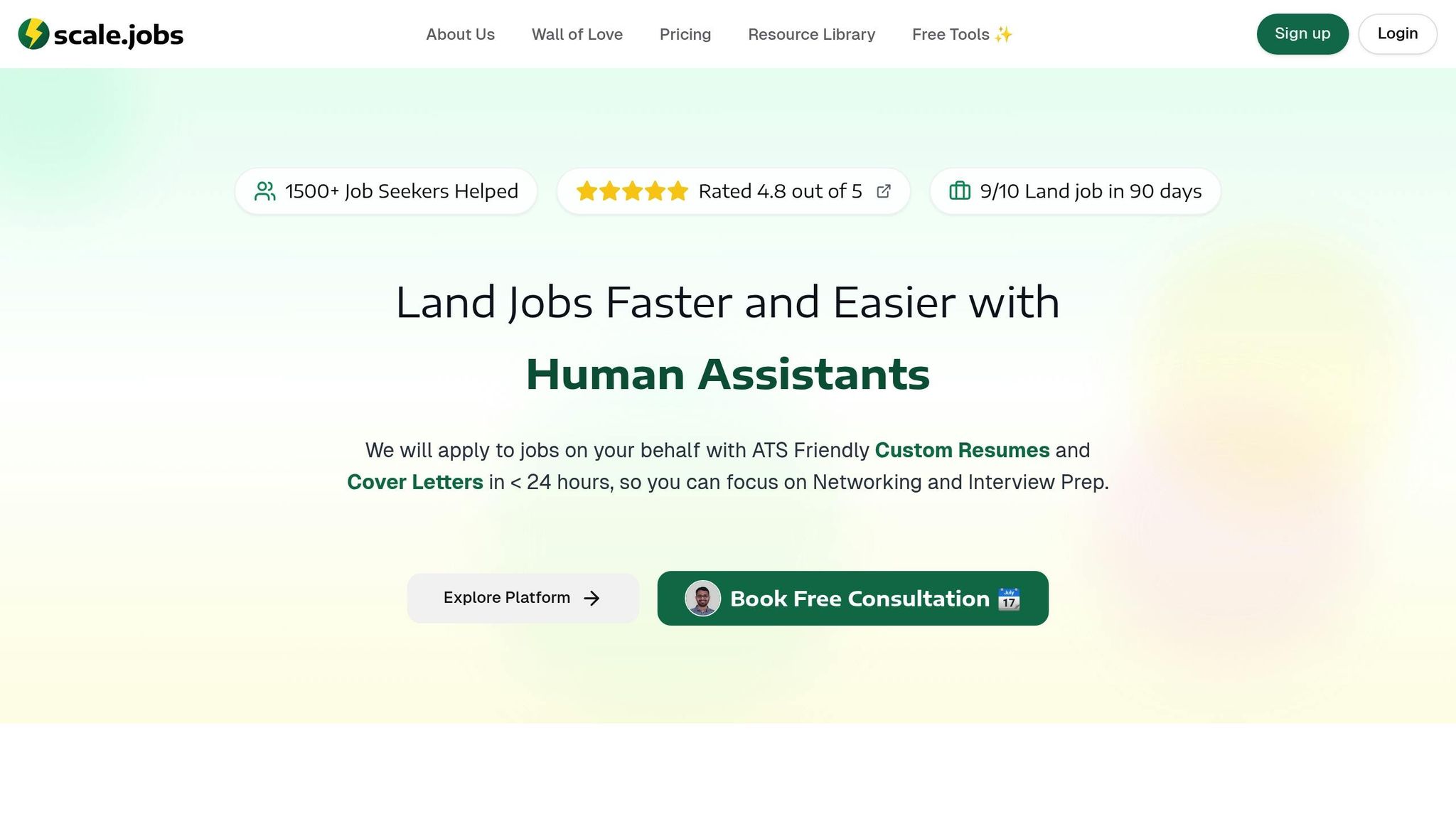Gender-Affirming Benefits: What Job Seekers Should Know
Explore the importance of gender-affirming benefits for job seekers, covering healthcare access, employer support, and state laws.

Gender-affirming benefits are employer-sponsored healthcare options that support transgender and gender-diverse individuals. These benefits cover treatments like hormone therapy, surgeries, mental health services, and more. They are medically necessary and significantly improve mental health and quality of life.
Here’s why they matter for job seekers:
- Financial Relief: Gender-affirming care can cost thousands annually; inclusive benefits remove financial barriers.
- Workplace Support: Employers offering these benefits demonstrate a commitment to equity and inclusion.
- Mental Health Impact: 78% of transgender individuals report better mental health after receiving care.
When job hunting, evaluate employer policies, health plans, and state laws affecting access to care. Check resources like the Human Rights Campaign's Corporate Equality Index or platforms like scale.jobs to find LGBTQ+-friendly employers. During interviews, ask specific questions about coverage and workplace culture to ensure your needs are met.
What Gender-Affirming Healthcare Coverage Includes
Services Covered by Most Plans
Gender-affirming healthcare provides critical medical and psychological services for transgender and gender-diverse individuals. While the specific treatments covered depend on the insurance plan, many inclusive employers offer coverage for several essential areas.
Hormone therapy is a key component, involving the use of estrogen or testosterone to help individuals develop physical traits that align with their gender identity. Most insurance plans that include gender-affirming care list hormone replacement therapy (HRT) as a standard benefit.
Surgical procedures address physical transitions in several ways. Top surgery focuses on the chest, bottom surgery modifies genitalia, and facial surgery alters features to appear more traditionally masculine or feminine. The extent of surgical coverage varies widely - some plans cover all procedures, while others limit coverage to specific types.
Mental health services are another cornerstone of gender-affirming care. These services often include therapy and counseling to address gender dysphoria and the emotional challenges of transitioning, offering vital support throughout the process.
Voice therapy is also commonly covered, helping individuals adjust their vocal characteristics to better match their gender identity. This can significantly impact both professional and social interactions.
"Despite gender-affirming surgery being a crucial part of the physical and emotional wellness of gender expansive people, it wasn't covered by major insurance companies for many years. Recently, the number of insurance companies and the range of services covered have increased, allowing people to access this important form of health care."
Progress in workplace benefits is evident. According to the 2024 KFF Employer Health Benefit Survey, 24% of large employers (200 or more employees) now include gender-affirming hormone therapy in their health plans.
These services often come with specific eligibility requirements, which are outlined below.
Medical Necessity Requirements for Coverage
Insurance providers and employer health plans typically require medical necessity documentation before approving gender-affirming treatments. Meeting these requirements is a crucial step in accessing care.
Most plans require letters from healthcare providers to confirm the medical necessity of the requested treatments. For surgeries, this often includes 12 months of continuous hormone therapy and letters from two providers - one of whom must be a licensed mental health professional.
Pre-authorization is another common requirement for surgical procedures. This involves submitting detailed documentation to the insurance company to confirm whether the treatment will be covered. Understanding these steps is essential when evaluating employer-provided benefits, especially during job interviews where you can inquire about pre-authorization processes.
Gender-affirming treatments are classified as medically necessary rather than cosmetic. This distinction is critical for securing insurance coverage and reflects the broader medical consensus that gender dysphoria is a legitimate condition requiring appropriate care.
Some plans may initially exclude gender-affirming care, but individuals can often request exceptions or advocate for the removal of these exclusions. Additionally, the Affordable Care Act prohibits discrimination based on gender identity, offering another layer of protection when seeking coverage.
State policies further shape the availability of these benefits, as detailed below.
Coverage Differences by State
Across the U.S., access to gender-affirming healthcare varies significantly by state, creating a patchwork of coverage. As of July 17, 2025, 26 states and Washington D.C. explicitly include transgender-related healthcare in Medicaid, while 11 states explicitly exclude it for individuals of all ages.
In 2023, Colorado became the first state to include gender-affirming care services in its benchmark health insurance plan for essential health benefits. This milestone has since encouraged other states to follow suit.
The disparities are stark. 58% of the LGBTQ population resides in states where Medicaid explicitly covers transgender-related healthcare, while 29% live in states where it is explicitly excluded. Among the approximately 276,000 transgender adults enrolled in Medicaid nationwide, 60% (164,000) have affirmative access to coverage under state policies, while 14% (38,000) live in states with explicit bans.
Federal protections under Section 1557 of the Affordable Care Act prohibit healthcare discrimination based on gender identity. However, state-level policies can either strengthen or weaken access to care, creating additional hurdles for some individuals.
Currently, 27 states have laws restricting or banning best practice medical care for transgender youth. This adds complexity for families and young adults entering the workforce. For example, the Supreme Court's June 2025 decision in US v. Skrmetti upheld Tennessee’s ban on gender-affirming healthcare for transgender youth, setting a precedent that may influence other states' legislation.
For job seekers, understanding how local regulations impact healthcare access is essential. Companies operating in multiple states may offer varying levels of benefits depending on state laws and insurance requirements.
| Coverage Type | States with Explicit Coverage | States with Explicit Exclusions | States with Unclear Policy |
|---|---|---|---|
| All Gender-Affirming Care | 26 states + D.C. | 11 states | 10 states |
| Minors Only Exclusions | N/A | 3 states | N/A |
| Youth Care Restrictions | N/A | 27 states | N/A |
State-level policies have a direct impact on access to care through employer-sponsored benefits, especially for those who may need to relocate for work.
Transgender Inclusion in the Workplace: Providing Inclusive Benefits
How to Find Employers with Gender-Affirming Benefits
Finding employers that offer gender-affirming benefits takes more than just scanning job descriptions. While 72% of respondents in an Indeed survey noted their employers provide health insurance covering gender-affirming care, knowing where to look and what to ask can make a big difference.
What to Look for in Job Postings
Job postings can offer subtle hints about a company's approach to LGBTQ+ inclusion. The best-case scenario? Employers that openly mention gender-affirming benefits in their listings. This transparency reflects confidence in their commitment.
Pay attention to mentions of mental health support and travel reimbursement for gender-affirming care - these are strong indicators of an employer's understanding of the unique needs of transgender employees, especially in areas where access to care is limited. Companies that emphasize diversity in their hiring practices are also more likely to extend these benefits.
Additionally, postings that use gender-neutral language and highlight workplace safety suggest a broader commitment to inclusion.
"There's a strong portion of the LGBTQ+ community that do not want to work for employers who do not offer inclusive benefits, and now added into the equation, do not want to work for employers who are located in places where they may not be feeling safe." - Scott Dobroski, VP of Corporate Communications at Indeed
This sentiment is echoed by the fact that over a third of LGBTQ+ individuals actively avoid companies in states with restrictive legislation.
Resources for Finding LGBTQ+ Friendly Employers
The Human Rights Campaign (HRC) Corporate Equality Index is a go-to resource for evaluating workplace policies and benefits. It includes an employer search function that allows you to filter companies based on criteria like transgender-inclusive healthcare.
In 2022, 662 major businesses had formal gender transition guidelines, and 91% of CEI-rated companies offered at least one transgender-inclusive healthcare option. These numbers highlight progress, but also underscore the importance of relying on verified tools rather than assumptions.
There are also online directories and specialized resources designed to help job seekers find LGBTQ+-friendly employers and healthcare providers. For instance, FOLX Health partners with employers to deliver comprehensive LGBTQ+ healthcare coverage.
Real-life stories illustrate the impact of inclusive workplaces. Take Molly, a Capital One employee, who transitioned while working at the company and felt fully supported:
"I transitioned from male to female while working at Capital One, and the sheer amount of support I received continues to overwhelm me. My manager and my skip leader observed that the quality of my work had made a huge leap after I became comfortable with my full self. That's the power of inclusion." - Molly, Capital One Employee
Another example is EY's Pathways to Transition program, which offers employees up to $50,000 for gender-transition-related expenses not covered by insurance. Initially capped at $25,000, EY doubled the amount in 2019 to ensure employees could access necessary care. On average, five employees use this benefit each year.
"You can't say you have equity and inclusion if you exclude a population with benefit needs." - Wendy Edgar, EY Americas HR Director
Platforms like scale.jobs simplify the process of finding employers with gender-affirming benefits. Their human assistant services and AI-powered tools can help job seekers identify inclusive companies and tailor applications to highlight shared values.
Questions to Ask About Benefits During Interviews
Asking the right questions during interviews can clarify an employer's commitment to gender-affirming care. Since transgender employees are 1.5 times less likely than cisgender colleagues to find benefits easy to understand, clear communication is key.
Consider asking:
-
"Does our health plan cover transgender healthcare needs, including routine care and gender-affirming procedures? Are there any exclusions?"
This sets expectations for baseline coverage. -
"Does our health plan align with the current World Professional Association for Transgender Health (WPATH) Standards of Care?"
This ensures coverage for medically necessary procedures. -
"Does the plan follow WPATH guidelines for documentation and pre-authorization?"
Understanding approval requirements helps avoid surprises down the road.
Beyond healthcare, explore workplace culture by asking about LGBTQ+ employee resource groups, gender-neutral bathrooms, and inclusive parental leave policies. These elements provide a fuller picture of the company's values.
For those in restrictive states, ask about relocation or travel assistance for gender-affirming care. Employers committed to inclusion often recognize these barriers and provide support.
Research shows that 78% of trans people report improved mental health after receiving gender-affirming treatment. Having an employer that supports this journey can profoundly impact both personal well-being and workplace performance.
Comparing Employers and Job Search Platforms
Building on strategies to identify inclusive employers, here’s a breakdown of some top companies offering gender-affirming benefits and a comparison of job search platforms that help connect candidates to these opportunities.
Top Employers with Gender-Affirming Benefits
The availability of gender-affirming benefits varies widely, but some companies are leading the way with comprehensive healthcare options. Knowing which employers prioritize these benefits can save job seekers significant time and effort.
In the tech industry, several giants stand out:
- Google provides up to $75,000 in coverage for gender confirmation surgery and related medical services. They also offer a medical advocacy program specifically for transgender employees.
- Microsoft extends its health benefits to include the needs of transgender employees and their dependents in the U.S.
- Meta supports transgender employees with medical coverage for transition-related services, backed by a dedicated specialty team.
Other companies, like Adobe, go further by covering a broad range of medically necessary gender-affirming treatments, from surgeries to voice therapy, ensuring transition-related healthcare needs are met comprehensively.
In financial services, companies like PricewaterhouseCoopers (PwC) and Wells Fargo also demonstrate strong support. PwC offers a lifetime maximum of $75,000 for transgender-related procedures, including coverage for dependents. Wells Fargo provides extensive benefits, covering everything from gender confirmation surgery to facial feminization, voice therapy, and more.
Netflix not only covers gender confirmation surgery and hormone therapy but also offers up to $10,000 in travel reimbursement for accessing specialized care. This is an important consideration, as many transgender individuals must travel to receive necessary treatments.
Amazon provides unlimited gender transition benefits from day one of employment, including gender confirmation surgery and internal resources to assist transitioning employees. This immediate coverage eliminates delays in accessing care.
Some companies have been pioneers in inclusivity for decades. Xerox Corp. has offered transgender-inclusive health insurance since 1995, and AT&T was among the first to introduce anti-discrimination policies based on sexual orientation. Meanwhile, Airbnb aligns its health coverage with the World Professional Association for Transgender Health (WPATH) standards, ensuring that all coverage decisions are based on established medical guidelines.
Job Search Platform Comparison
While many employers provide robust benefits, the ability to connect with these opportunities depends heavily on the job search platform you choose. Here’s how some of the leading platforms measure up for LGBTQ+ job seekers:
- Find My Profession focuses on resume writing and LinkedIn optimization but lacks direct application support for targeting inclusive employers.
- Simplify.jobs automates job applications, but its reliance on bots can trigger ATS filters and doesn’t cater to the specific needs of LGBTQ+ candidates.
- Lazyapply.com sends out numerous applications automatically, but this "shotgun" approach often results in mismatched applications, failing to align with a candidate’s values or focus on inclusive benefits.
- Jobscan.co excels in optimizing resumes for ATS systems but doesn’t provide tools to connect with employers offering gender-affirming benefits.
- Teal HQ offers career coaching and job tracking but lacks targeted support for those seeking inclusive healthcare benefits.
Why scale.jobs Works Better for LGBTQ+ Job Seekers

For those prioritizing gender-affirming healthcare, precision and personalized support are key. scale.jobs stands out by addressing the unique challenges LGBTQ+ job seekers face, offering services that go beyond what traditional platforms provide.
- Human-Powered Applications: Unlike automated systems, trained virtual assistants handle each application personally, ensuring it reaches human recruiters and avoids ATS filters.
- Flat-Fee Pricing: With campaign bundles starting at $199 for 250 applications, job seekers can budget more effectively without worrying about recurring subscriptions.
- Real-Time Updates: Live WhatsApp notifications and proof-of-work screenshots provide transparency, showing exactly where and when applications are submitted.
- Customized Resumes and Cover Letters: Tailored documents are crafted within 24 hours to highlight relevant experience and values that align with inclusive employers.
- Flexible Platform Compatibility: Applications can be submitted across various platforms, from corporate ATS systems to niche job boards, offering the flexibility needed to target specific employers.
- Integrated Tools: With access to over 2 million monthly job postings, application tracking, resume building, and interview prep tools, scale.jobs simplifies the entire job search process.
- Free Tools: Features like ATS checkers, cover letter generators, and salary predictors help candidates craft competitive applications at no extra cost.
- Visa Support Expertise: For international candidates, scale.jobs provides assistance with complex visa processes, including H1B, F1, CPT, and more, ensuring access to inclusive employers worldwide.
Navigating the job market as an LGBTQ+ candidate can be challenging, but platforms like scale.jobs are designed to provide the targeted support needed to connect with employers offering gender-affirming benefits. Understanding your rights and how to address potential coverage issues is equally important in securing these benefits through employment.
Your Rights and How to Handle Problems
Many employers now offer inclusive benefits, but understanding your legal rights is key to ensuring you get the support you’re entitled to. Knowing the laws that protect you and how to challenge denied coverage can make all the difference. While state laws vary widely, federal protections provide a baseline for most workers.
Legal Protections for Gender-Affirming Care
Federal laws offer several protections against discrimination in healthcare. The Affordable Care Act (ACA) prohibits sex-based discrimination, which includes anti-transgender bias, by most health providers and insurers. Similarly, Title VII ensures that if insurance plans cover medically necessary procedures for cisgender individuals, they must also cover them for transgender individuals.
"Under the ACA, it is illegal for most insurance companies to have exclusions of transition-related care, and it is illegal for most health providers to discriminate against transgender people, like by turning someone away or refusing to treat them according to their gender identity." - A4TE
Other federal safeguards include the Health Insurance Portability and Accountability Act (HIPAA), which protects the privacy of health information, including transgender status. Medicare and Medicaid rules also guarantee that patients can choose their visitors and medical decision-makers regardless of legal relationships.
State laws, however, differ significantly. As of June 2025:
- 24 states and Washington D.C. have policies prohibiting insurers from denying gender-affirming healthcare.
- 15 states, one U.S. territory, and D.C. have laws banning insurance discrimination based on both sexual orientation and gender identity.
- 8 additional states focus specifically on gender identity protections.
Unfortunately, not all states provide these safeguards. While 55% of the LGBTQ population lives in states that ban transgender exclusions in insurance, 40% reside in states with protections for both sexual orientation and gender identity. However, some states explicitly allow insurers to deny coverage for gender-affirming care.
| State Protection Level | Coverage Details | Population Impact |
|---|---|---|
| Comprehensive Protection | Covers sexual orientation and gender identity | 40% of LGBTQ population |
| Transgender-Specific Protection | Covers gender identity only | Additional 15% of LGBTQ population |
| Limited or No Protection | No specific protections or explicit exclusions allowed | Remaining 45% of LGBTQ population |
These protections provide a foundation for addressing denied coverage.
What to Do if Coverage Is Denied
If your health plan denies coverage for gender-affirming care, there are several steps you can take to challenge the decision:
- Request documentation: Obtain the denial letter, which explains the reason and outlines the appeals process.
- Work with your healthcare provider: Collect clinical documentation, statements of medical necessity, and detailed treatment plans to support your case.
- File an internal appeal: Submit all relevant medical documentation to your insurance company, as this step is typically required before pursuing external options.
- Seek an external review: If the internal appeal fails, request an independent third party to review your case.
- Reach out to legal organizations: Groups like the National Center for Lesbian Rights, Lambda Legal, the Transgender Law Center, and the ACLU provide legal support and guidance.
- File discrimination complaints: Contact the U.S. Department of Health and Human Services to investigate potential ACA violations.
- Advocate with your employer: Present documentation showing potential federal law violations and request the removal of transgender exclusions from the health plan.
When Employer Benefits Are Not Enough
If your employer’s benefits don’t cover enough, external programs can help fill the gaps. Organizations like Point of Pride offer financial assistance and direct support for transition-related expenses:
- Annual Trans Surgery Fund: Financial help for gender-affirming surgeries.
- HRT Access Fund: Provides 12 months of free hormone therapy care.
- Electrolysis Support Fund: Covers permanent hair removal services.
- Thrive Fund: Offers small grants for wigs, prosthetics, fertility preservation, vocal training, and more.
- Free chest binders and femme shapewear: Available for those unable to obtain these items safely.
Gender-affirming care has been shown to greatly improve overall well-being. Research reveals that 78% of transgender individuals report better mental health after receiving gender-confirming treatment. Conditions like depression, anxiety, and stress often decrease, and suicide rates drop. Nearly all individuals who accessed gender-affirming hormones (98%) or surgeries (97%) reported greater life satisfaction.
Efforts to improve workplace benefits are ongoing. In 2022, 662 major companies implemented gender transition guidelines, and 91% of businesses rated by the Corporate Equality Index offered at least one transgender-inclusive healthcare option. Yet, transgender employees are still 1.5 times less likely to find their benefits easy to understand compared to cisgender colleagues, highlighting the need for continued education and advocacy.
"LGBTQ+ patients deserve healthcare providers who they can be open and honest, free from fear of stigma or bias." - GLMA
Finding inclusive healthcare providers can be challenging, but resources like the LGBTQ+ Healthcare Directory can help connect you with affirming professionals. Tools like the Healthcare Equality Index (HEI) also guide organizations in creating LGBTQ+ patient-centered care, expanding access to inclusive healthcare options.
Conclusion
For transgender and non-binary job seekers, finding an employer that offers inclusive gender-affirming benefits is more than just a perk - it's essential. Studies reveal the profound impact these benefits have on mental health. For example, access to hormones and puberty blockers for youth aged 13 to 20 is linked to a 60% lower likelihood of moderate to severe depression and a 73% lower chance of self-harm or suicidal thoughts. Similarly, gender-affirming surgeries for adults are associated with a 42% drop in psychological distress and a 44% decrease in suicidal ideation. These numbers highlight why such benefits are critical in today’s workplaces.
The job market reflects this growing need for inclusivity. Many LGBTQ+ professionals actively avoid companies that lack supportive policies or are based in states with restrictive legislation. As mentioned earlier, employees want employers who show a year-round commitment to inclusion - not just during Pride Month.
It’s also worth noting that benefits account for about 30% of total compensation, which means they play a major role in job decisions. No paycheck should outweigh your right to inclusive healthcare. Resources like the Human Rights Campaign Corporate Equality Index can guide you in identifying supportive companies. During interviews, don’t hesitate to ask specific questions about the gender-affirming benefits they offer.
Federal laws protect your right to non-discriminatory healthcare coverage, empowering you to advocate for comprehensive benefits. As LinkedIn LGBTQ+ career expert Andrew McCaskill puts it:
"Professionals want to be able to really love and like the companies they work for all 12 months of the year, not just during June and pride month."
Seek out employers who actively prioritize LGBTQ+ inclusion through their policies and benefits. Tools like scale.jobs can help you connect with these companies through tailored job searches and application support. Your career deserves to flourish in an environment that fully values and supports your identity.
FAQs
How can I find companies that provide comprehensive gender-affirming benefits?
To find companies that provide gender-affirming benefits, start by exploring their official career pages or employee handbooks for details on benefits policies. Employers recognized for inclusive healthcare coverage, such as those featured in the Human Rights Campaign's Corporate Equality Index, are a good place to begin. Employee reviews and advocacy resources can also offer insight into how these benefits are applied in real-world scenarios.
You can also look into publicly available lists of inclusive employers or use platforms like InHerSight or Built In to discover companies that emphasize transgender-inclusive health benefits. If you're unsure about specific coverage, consider reaching out to HR departments or insurance providers for clarification. Choosing employers with a proven commitment to inclusivity ensures better access to meaningful support.
What can you do if your insurance denies gender-affirming healthcare coverage?
If your insurance denies coverage, the first step is to request a copy of the denial letter to understand the specific reason behind the decision. Once you have that, collect any supporting documents that could strengthen your case - this might include letters or notes from your healthcare providers. Use these materials to file an appeal directly with your insurance company.
If your appeal is unsuccessful, don’t stop there. You can look into other avenues, such as contacting legal advocates, filing a consumer complaint, or seeking advice from organizations that focus on healthcare rights. These steps can help you push back against the denial and work toward securing the coverage you need.
How do state laws impact access to gender-affirming healthcare, and what should job seekers know before relocating?
State laws across the U.S. have a major impact on access to gender-affirming healthcare. By 2025, 27 states will have enacted bans or restrictions on this type of care, particularly for minors. These laws can significantly limit access to crucial medical services, which might be a decisive factor for individuals thinking about relocating.
If you're job hunting and considering a move, it's essential to research the legal and healthcare landscape of your potential new state. Knowing the local policies on gender-affirming care can help you make well-informed choices about where to settle. It’s also worth exploring employers that provide inclusive healthcare benefits to ensure you have access to the necessary support.




